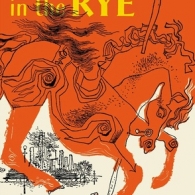Jerome David Salinger is an American writer who is primarily known for his “The Catcher in the Rye” novel. The novel was primarily intended for the youth audience but is now popular among all age groups. Salinger’s books open to the readers a world of a naïve and delicate artist who reminds each and every one of us how important it is to love each other, to support each other, to respect and not dominate.
Jerome Salinger was born on January 1, 1919, in New York. In 1936 Jerome graduated from military academy in Pennsylvania. Despite the fact that he was a mediocre student, it was here that his writing career began. Salinger edited the yearbook of his class and was writing short stories in his room at night. Jerome also contributed a couple of line for his school’s anthem that is performed even nowadays.
In 1937 he attended lectures at the New York University, but never managed to graduate. He soon left the school and during 1937-1938 worked in Austria and Poland, as he was encouraged by his father to study the meat processing business. After leaving Europe Jerome spent some time at the Ursinus College in Pennsylvania. Here he also continues his sporadic writing efforts, writing columns and movie reviews.
Without obtaining a finished diploma at the Ursinus College, in 1939 Salinger frequented Columbia University. Here he loved the lectures on short story writing. These lessons were lead by an editor of the “Story” magazine. Whit Burnett even chose one of Salinger’s stories to be published in the magazine. The text was entitled “The Young Folks” and today it is considered Salinger’s debut in the grown-up writing world.
Jerome David Salinger didn’t manage to obtain a diploma or a finished degree from any of these educational establishments. He also didn’t demonstrate any outstanding results or talents there. His father was very disappointed because of this and their relationship worsened over years.
Salinger managed to get close to Whit Burnett and the editor continued mentoring young Jerome several years after Salinger last attended his class. Salinger also managed to meet Ernest Hemingway and the latter praised highly his writing talent.
In 1942 Salinger was called to serve in the army. It is important to note that writer’s family was of Jewish origins. His grandfather was a rabbi and Salinger’s mother considered herself Jewish and even changed her name to Miriam from Marie after marriage.
In the army, Salinger served in multiple divisions: from interrogating soldiers at the counter-intelligence units to entering into the liberated concentration camps as Staff Sergeant. He experienced an incident of posttraumatic stress and his daughter recalled him telling to remember the war as vividly as if it happened yesterday.
After his writing debut in 1940 in “Story” magazine, Salinger kept knocking on the door of American publications, but, unfortunately for him, “The New Yorker” rejected a good deal of his texts. His next big publication was in 1948 when “A Perfect Day for Bananafish” appeared in “The New Yorker”. It was a story about one day in a life of Seymour Glass and his wife Muriel.
11 years after his first debut, the writer published his most known novel “The Catcher in the Rye” in 1951. The writer worked on this text since 1941. “The Catcher in the Rye” was met by critics with positive reviews.
Holden Caulfield, the protagonist of the novel, studies at school and lives in a dormitory. He dreams of escaping from his everyday life. He wants to live by nature and do more things himself. He isn’t a bright student, but he wants his sister to study harder. He is kind, knows how to have fun, laughs a lot, always eager to help others, especially children.
His internal chaos, inability to adapt to the circumstances in life, idealistic mindset inevitably makes the reader worried about Holden’s future. The writer managed to make each reader feel a part of Holden’s destiny and life. Salinger reminded the youth and the adults that everybody who enters this life needs to be loved and supported. The writer also teaches his young readers to think carefully about their actions, learn from others and find their purpose in life.
By the time “The Catcher in the Rye” was published, 26 of Salinger’s stories and essays already appeared in various magazines and newspapers. Seven of them will appear again in the “Nine Stories” book (also known under a title of "For Esmé—with Love and Squalor" in Europe). This collection earned high review and was a commercial success for the author.
“Franny and Zooey” (1961) and “Raise High the Roof Beam, Carpenters (1963) are a continuation of the stories about Glass family. The first book is composed of two stories about Glass siblings, and the second book is narrated by one of the Glass family members while on army leave.
In 1965 Salinger published “Hapworth 16, 1924” which will become his last published novel. This book will close the cycle, as some may say, because the text is narrated by a young Seymour Glass, who will later become the protagonist of Salinger's other novels. The author has inserted a good amount of his own critique and comments regarding other writers and their works.
After 1965 Salinger stopped publishing and almost disappeared from the public eye. All his publications after “The Catcher in the Rye” were composed of works that appeared earlier in magazines. He stopped a couple of publications of his earlier works and letters. In these years Salinger continued practicing Zen Buddhism and a number of other spiritual practices that he got to know since the 1940s.
Salinger died at his house in New Hampshire on January 27, 2010, at the age of 91 years old.

